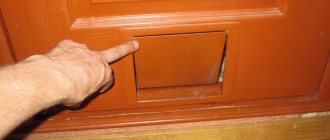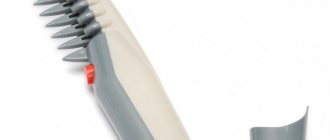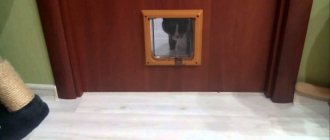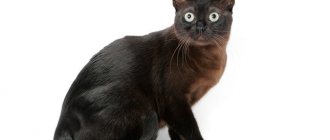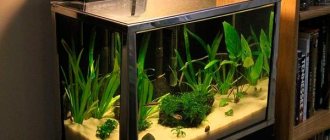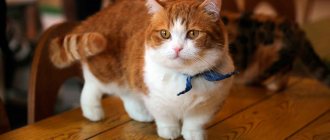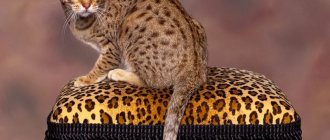Having a pet in the house imposes a number of responsibilities on the owners, which include not only providing food, veterinary care and hygiene procedures.
Felines, as bright representatives of freedom-loving animals, should be able to move freely throughout the house and go outside at any time. To make this possible without human intervention, a cat door, purchased at a pet store or made by hand, is installed in the door leaf.
Making a door for a cat with your own hands
It’s rare that a cat owner isn’t familiar with this phenomenon: it’s 5 am, and the cat outside the door is showing impatience and sometimes making very loud noises. You have to get up, open the door for your furry pet, and then wait until the latter returns home and open and close the entrance door again.
Cat door
However, this problem can be solved, especially when it comes to a private home.
cat door
There are many such devices. You can always purchase the best option at a pet store, and in extreme cases, making it yourself is not so difficult - unless we are talking about a metal entrance structure, of course.
Choosing finished products, as well as imagining your own handicraft, must take into account several factors:
- purpose of the passage - the door is installed only so that the cat can toilet, but also so that the animal can freely move from room to room, go out onto the loggia, and so on;
- material - the product can be made of aluminum, plastic, wood. The choice depends mainly on the sash material;
- sizes - from 10*10 to 15*15 cm, in some cases this is not enough;
- variety - there are several different types of models. Of course, it’s difficult to give an animal a choice, but the owner needs to take design features into account when choosing.
Cat flap in door
Products are produced in 3 main types.
- Manhole - made in the form of a window or tunnel and is intended mainly for installation on interior models. This device does not have its own flaps; in fact, it is a version of the hole. At best, it is equipped with a curtain that acts as a brush. When a cat goes to the toilet, it also cleans its fur. The downside of the product is that the curtain does not protect against smell and noise. The animal will not shit under the door, but the smell remains audible. In the photo there is a hole for a cat.
- The window is equipped with a sash mounted on hinges. The door opens freely, the animal can push it in any direction when entering or leaving the room. The smell is thus blocked. If desired, a lock or latch is installed on the door when they want to close the room from the cat.
The downside of the product is that the lock is unreliable. So this option is not suitable for the front door. In addition, the sash makes a rather loud sound when it opens or closes.
- The door itself is, or rather, a tunnel with a hinged flap. Typically made of wood or plastic. The presence of a tunnel makes it difficult to use such a model for unauthorized access to the house. However, the product is noticeably more expensive. But if cats shit under the front door, then this option can be considered the best. The photo shows the finished product.
Modern modifications can provide other benefits. For example, folding tunnel doors with a magnetic latch. The magnet is weak enough, the animal can easily open the doors, but at the same time they immediately slam shut and close tightly. Thus, the home remains protected from insects, and heat will not escape through a loosely closed hole.
We make the door ourselves
It is easy to make a cat door with your own hands. This will only require time, a little money and certain skills. First purchase plastic, sealant, latches, and a small piece of fleecy fabric.
Before you start work, check that you have everything you need at hand: jigsaw, hacksaw, drill, pencil, ruler, level, construction knife, sanding materials, screwdriver, square. A sealant will definitely be needed.
To begin, choose a location to install the door, take measurements and cut a hole. Be sure to sand the cut and decorate it.
If the door was wooden, then the remaining piece can be secured on hinges. This way you can avoid incurring unnecessary costs and wasting time. However, there is one “but”. It’s not a fact that a cat will want to push a heavy wooden door. Therefore, the best way out of the situation is lightweight plastic or hardboard glass.
To ensure a tight fit of the door, you need to install two magnets: one at the top, the other at the bottom. If you want to limit the “travel” of the animal, install a latch on the door and close it if necessary. To provide sound insulation and heat escape, attach a seal around the perimeter of the cat door.
Advantages and disadvantages of the solution
Constructing a manhole with your own hands or purchasing a finished product is actually a very practical solution.
- There is no need to purchase cat litter, and this significantly reduces costs.
- The animal does not shit under the door or in any other place, since it can always come out.
- Eliminates the need to clean cat litter.
- The risk of infection to people is reduced, since the cat does not spread the filler on its paws. And the latter absorbs smell, dirt, and pathogenic microflora.
Do-it-yourself door for a cat to the toilet
The technology for making such a craft is very simple. As a rule, the doors themselves are made of wood. Since such material is almost always available to the home craftsman. However, you can use plastic sheets, cable, and fabric.
- Remove the door from its hinges and place it on a flat surface.
- Cut a hole in the canvas of the required size - from 10*10 to 15*15 cm.
In this form, the sash can be installed back: the hole is enough so that the cat does not shit under the door, but passes through freely. However, the appearance of this design is not aesthetic and does not protect against odor.
- Make 4 wooden planks according to size and close the ends of the resulting hole.
- Hinges or hinges are attached to the opening, depending on whether the doors will rotate or tilt.
- The door is cut out of light wood or a sheet of plastic and hung on hinges. The cat opens the door only lightly, without effort, so the rotation should be very light.
- The interior or entrance door is installed in its original place.
This video demonstrates how to make a cat door yourself.
What types are there?
The market is diverse and you can choose a product to suit every taste. Install cat gates in the interior or entrance door. There are these types:
- With a chip - it becomes open only when the tailed one approaches. The downside is that a cat door with a microchip requires a special device to be implanted into the animal’s body.
- With a key - equipped with a special magnetic key, which is located on the collar. When your pet approaches, the magnet is triggered automatically and the door opens. Can be configured for input only or output only. Suitable for small kittens who are accustomed to a collar.
- Grille with security locks - 2 and 4 variations. The tunnel for the cat has a limiter for entry and exit, and can be adjusted to only outward or inward modes. You can keep it locked and not allow the animal into the room.
Such a passage for a pet can even have an intricate shape.
There are also cat doors built into the wall. Each type is equipped with a tunnel for easy installation and passage of your pet through it. It has an automatic curtain built into it, which rises when a cat passes through it and then silently clicks into place. The systems can be easily locked with a magnet if necessary to completely isolate the cat in the room.
DIY cat door
Sometimes it may seem that your beloved cat wants to unsettle you due to its desire to move freely around the house. Now she needs to go to the balcony, now from the balcony, now into the room, now out of the room. And every now and then you have to walk behind your pet and open and close the door while caring for it. What to do in such a situation? Some owners prefer to install a cat door themselves rather than endlessly groom their pet.
Such a door will allow the cat to independently enter and exit from one room to another whenever she wants. A quality cat door can be installed in both interior and exterior door systems. The simplest cat door can be made using wood or plastic. To ensure safety, the structure is equipped with a latch and a sash.
Electronic door
The design of the product is similar to a mortise door, but is supplemented with electronic sensors that protect the entrance from the entry of foreign animals into the home. Electronic doors are opened using a chip built into the collar of a domestic cat.
This system is ideal for country houses, since with the help of sensors you can track the movements of the animal and always know where it is.
Types of passages for pets
All designs have their own distinctive features; as for the cat door, it may differ in size and type of material. To make a passage for an animal, in addition to plastic and wood, aluminum can also be used.
The simplest option, which is most popular, is a manhole in the form of flaps. The frame for it is made of aluminum, and the doors are made of plastic. Such a door, made by yourself, will not affect the degree of thermal insulation in the house. Therefore, it can even be installed on an external door system.
If you are afraid that a strange cat will enter your house, then you can purchase a special sensor that receives and transmits a signal that comes from a microchip built into the cat’s collar. This means that besides your pet, no one else will get into the house. However, before you get started, you should measure the dimensions of the cat, which will allow you to decide on the size and shape of the door.
In pet stores, you can be offered 3 options for doors for animals: a window, a manhole and a door. Before you make any of these options yourself, familiarize yourself with the features of these devices. The manhole allows the cat access from one room in the house to another or provides access to the street. As a rule, the manhole does not have doors and is installed in interior door structures. The disadvantage of this move for the cat is the penetration of foreign odors and noises from one room to another.
Rating of cat doors
- Trixie window for cats;
- Ferplast Swing Microchip – automatic door with microchip detector;
- Flamingo leaf door;
- Trixie 3867 XL Large Cat Door;
- Ferplast Swing 7 set – with magnet.
Trixie cat window – choice for interior doors
The passage for a cat in the door is like a “window”. The model is made of white plastic. The movable shutter is transparent. Suitable for cats of all ages and small breed dogs. Product dimensions: 17.7×18.7 cm. Hole depth – 17-34 mm. The depth can be expanded with additional elements.
- Plus: quiet mechanism.
- Minus: does not have locks.
Price: 1742 rub. More details about the product
Cat door. Do it yourself!
To avoid mistakes, plan your work on arranging a cat hole and follow the plan exactly. To begin, remove the door in which you plan to install a shutter for your pet from its hinges. Place it on a flat surface.
Now cut a hole at the bottom of the door leaf, which can be from 10x10 cm to 15x15 cm. It all depends on the size of your pet. To ensure your door remains aesthetically pleasing, the base of the cat hole should be treated to form a frame. At the top of the cat hole, install swivel and swivel hinges or hinges. Now fasten the finished doors on their hinges and install the door leaf in place.
A cat toilet door made of wood may be too heavy for the animal, which is why your pet will not be able to open it. Therefore, perhaps the best option would be to install a plastic door. A latch, for example, a regular latch, can act as a lock.
If you have any questions about making a door for a cat, then write comments on the article.
Opened door
In essence, this is a simple hole cut into the door leaf according to the size of the animal. It has no doors and is designed to allow cats to pass through interior doors. At the entrance to the house, such a product is sometimes installed only in summer country houses.
Its main advantages:
- Easy to manufacture;
- Easy installation;
- Unlimited movement of the animal.
The hole shape can be any. Its edges are usually trimmed with a strip of fleecy cloth or a brush to collect hair during shedding. However, the hole does not provide tightness and does not allow control of the animal’s movement.
Main types
Cat doors come in different types. Manhole is the simplest option. This is an interior solution, since it is not suitable for the role of an entrance door. This is a kind of hole through which the cat gets into the room it needs. In order not to spoil the design of the apartment, the manhole is made in an interesting and original shape. You can install special brushes. When the animal enters the room, excess hair will remain on the brush. Such a unique passage will become an ally in the fight for cleanliness.
The disadvantage of this design is that, if necessary, it is impossible to isolate the pet. Also, the hole will not be able to prevent foreign odors and sounds from entering the room.
Window
A window differs from a manhole in the presence of a movable door. It consists of a metal or wooden frame and a movable plastic plate. Just like a manhole is not suitable for the front door, since uninvited guests, such as stray cats, can enter the house through it. If you install a sash lock, you can prevent the neighbor's cats from entering the apartment, but this process will also have to be controlled by the owners.
Ferplast Swing Microchip
Automatic cat door with microchip detector made of brown plastic. The unique system, which includes a microchip, is patented by Ferplast.
The model is suitable for installation in glass, plastic and wooden doors, as well as in walls. The opening system works as follows: the antenna reads the microchip that is installed in the cat’s collar when it approaches the door.
The door memory can store 32 ISO chips at a time. Chips are written to the system memory by pressing the memory button.
The entry and exit indicator informs the owner where the pet is currently located. It has 4 operating modes: input, output, closed and microchip input. Product dimensions: 22.5×25.2 cm.
- Plus: suitable for installation in entrance doors.
- Disadvantage: high cost.
Price: 17998 rub. More details about the product
Flamingo leaf door
The plastic leaf door (window type) has two working positions: entry, exit. The model is made of high quality white plastic.
Suitable for inserting into glass and wooden interior doors. Product dimensions: 19.2x20 cm. Passage depth: 16.5x17.4 cm.
The passage opening can be expanded with additional tunnels, which must be purchased separately.
- Plus: easy to install.
- Minus: not suitable for entrance doors.
Price: 1068 rub. More details about the product
Extended XL cat door Trixie 3867
The larger model TX-3867 can be installed on doors with a thickness of 17-34 mm. With the help of additional tunnel elements, the passage depth can be expanded to 45 mm.
The door is fixed in a vertical position using a magnetic clamp at the bottom of the product immediately after the cat passes through - this is protection from drafts. The presence of a sealing edging allows for silent closing of the sash.
- Plus: it closes without slamming.
- Cons: high price.
Price: 1850 rub. More details about the product
Ferplast Swing 7 set
The automatic folding model for cats and small dogs made of non-toxic plastic is equipped with a draft prevention system. Works in 4 modes, has 4 locking directions.
Installed in doors made of glass, wood, metal or in walls. The last passage indicator helps the owner to know where the animal is: on the street or in the house.
The door is opened using a magnetic key, which is attached to the animal's collar. Product size: 25.2×22.5 cm. Passage depth: 9.6 cm.
- Plus: automatic opening using a magnetic key.
- Disadvantage: high cost.
Price: 2999 rub. More details about the product
What to consider when choosing
When choosing a door for a cat, you should first decide: it will be a passage to the toilet or for other interior movements. Perhaps through the hole the pet will go out onto the loggia or onto the street. You will also have to choose the material from which the door will be made. Next, you should decide on the size and think about which type will suit you and your pet best.
If you are the owner of several purrs, then count on the most well-fed one. Add 5 cm to all parameters of the animal - this will be the size of the passage. If you don't want your sleep to be interrupted by a slamming door, don't cut a window into your bedroom door. Place such structures on the doors to the bathroom and toilet rooms.
Window with sash
The simple design resembles a manhole, complemented by a hinged door. The opening is usually rectangular or square in shape and is covered by a door that can operate in both directions.
- The door opens by simply pressing the head.
- With its help, you can limit the cat's movement by installing a clamp.
- The product is mounted, like a manhole, on interior doors or at the entrance of country houses.
Its main drawback is the loud knocking sound when the sash is closed and the risk of pinching your pet's tail.
How to make it yourself
Tools and materials
Having studied the listed types of cat doors, you can see that such a design can be made with your own hands. So, if you have already chosen the appropriate option, then decide on the material. You will need:
The frame must be wooden; the door is also made from this material. Plastic is an inexpensive material; manholes are made from it. Rubber is useful for increasing sound insulation; it is laid around the perimeter of the door. You can decorate the passage with fabric.
Window
This design is designed for free passage of the cat and is installed directly into the entrance or interior door. It consists of glass or plastic and a metal or wooden frame.
The cat window is well insulated and will not let in odors, unlike a regular cat window. If desired, you can easily close the passage using a latch or a simple lock. It is very easy to make such a design yourself.
One of the disadvantages is the lack of noiselessness. The structure will clap or creak every time an animal passes through it. For this reason, windows are rarely installed in interior doors, since such sounds can irritate or interfere with rest.
